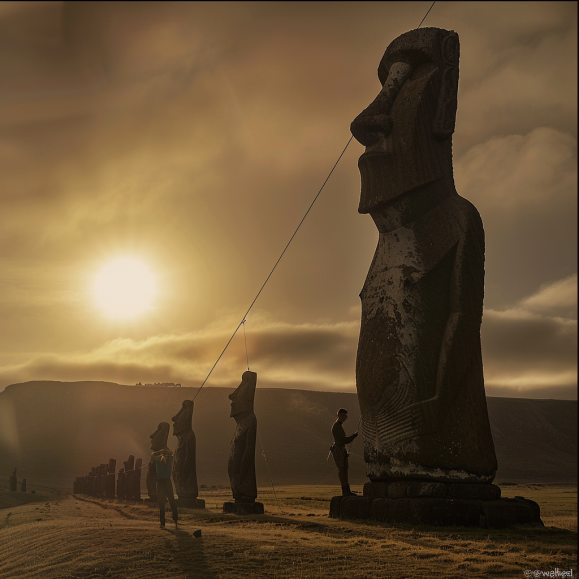Introduction
Easter Island, known for its enigmatic Moai statues, has captivated historians and archaeologists for centuries. These colossal stone figures, some weighing up to 82 tons, are scattered across the island, far from their original quarries. The mystery of how these statues were transported has sparked numerous theories. Recent research has unveiled that the Moai were “walked” to their locations using an ingenious system of ropes and human coordination. This revelation not only demystifies their transportation but also showcases the exceptional ingenuity and cooperative spirit of the Rapa Nui people.
The Discovery of Easter Island’s Moai Statues
Easter Island, or Rapa Nui, is home to nearly 1,000 Moai statues. These iconic monoliths, carved between 1400 and 1650 CE, are a testament to the island’s rich cultural heritage. The Moai, with their imposing figures and solemn expressions, were crafted from volcanic tuff and stand as guardians of the island.
Physical Characteristics of the Moai
The Moai statues vary in size, with the tallest reaching over 10 meters. They are characterized by their disproportionately large heads, elongated ears, and deep-set eyes. The statues are believed to represent important ancestors, embodying spiritual and political power.
Traditional Theories of Transportation
For years, scholars debated various methods for moving the Moai from the quarries to their final locations. Early theories suggested the use of wooden sledges, rollers, or even supernatural assistance. However, these theories often lacked concrete evidence and failed to fully explain the process.
The “Walking” Theory
Recent studies propose that the Moai were moved by “walking” them across the island. This method involved tilting the statues forward and rocking them from side to side, creating a walking motion. The process required precise coordination and teamwork, demonstrating the Rapa Nui people’s exceptional engineering skills.
Rope and Human Coordination Techniques
The walking method relied heavily on ropes and human coordination. Teams of workers would position ropes around the statue and, through synchronized pulling and shifting, gradually move the Moai forward. This technique minimized the need for external materials and showcased the Rapa Nui’s resourcefulness.
Experimental Archaeology: Proving the Theory
To validate the walking theory, researchers conducted experimental archaeology projects. By creating replicas of the Moai and employing traditional tools and techniques, they successfully demonstrated the feasibility of the walking method. These experiments provided tangible proof of the Rapa Nui’s ingenious transportation strategy.
The Role of Community and Cooperation
The successful movement of the Moai would have required the concerted effort of the entire community. The process fostered a sense of unity and cooperation, reflecting the social structure and collective spirit of the Rapa Nui people. It’s a powerful example of how communal efforts can achieve extraordinary feats.
Cultural Significance of the Moai
The Moai statues are more than mere monuments; they are deeply intertwined with the spiritual and cultural identity of the Rapa Nui. Each statue represents a revered ancestor, believed to possess mana, a spiritual force that protects and empowers the community.
Challenges in Preservation
Today, the preservation of the Moai is a critical concern. Exposure to the elements, erosion, and human activity pose significant threats to these ancient relics. Efforts are underway to protect and restore the statues, ensuring their legacy endures for future generations.
Modern Techniques in Archaeological Research
Advancements in technology have revolutionized archaeological research on Easter Island. Techniques such as 3D scanning, ground-penetrating radar, and drone mapping have provided new insights into the construction, transportation, and placement of the Moai.
Global Impact of the Discovery
The revelation of the walking method has captivated the global community, reshaping our understanding of the Rapa Nui culture. It highlights the innovative spirit and resilience of ancient civilizations, inspiring modern societies to look to the past for solutions to contemporary challenges.
Future Research Directions
Ongoing research aims to further explore the social and environmental factors that influenced the construction and transportation of the Moai. Studies focus on the ecological impact of deforestation, resource management, and the broader implications of the Rapa Nui’s engineering achievements.
Conclusion
The mystery of how Easter Island’s Moai statues were transported has fascinated scholars for decades. The discovery that these massive figures were “walked” into place using a sophisticated system of ropes and human coordination is a testament to the ingenuity and cooperative spirit of the Rapa Nui people. This remarkable achievement not only solves a long-standing archaeological puzzle but also highlights the innovative and resourceful nature of ancient civilizations.
FAQs
How were the Moai statues transported to their locations?
The Moai statues were transported by “walking” them using a system of ropes and coordinated human effort. This method involved tilting and rocking the statues from side to side.
What is the significance of the Moai statues?
The Moai statues represent important ancestors of the Rapa Nui people and are believed to possess mana, a spiritual force that offers protection and power to the community.
What materials were used to carve the Moai statues?
The Moai were carved from volcanic tuff, a relatively soft and workable rock found on Easter Island.
How long did it take to transport a Moai statue?
The time required to transport a Moai statue varied depending on its size and the distance it needed to be moved. The process could take weeks or even months.
What challenges do the Moai face today?
The Moai face challenges from natural erosion, weathering, and human activities. Preservation efforts are critical to protect these ancient monuments for future generations.
What have recent studies revealed about the Rapa Nui people?
Recent studies have highlighted the Rapa Nui people’s ingenuity, particularly their ability to move massive Moai statues using a sophisticated system of ropes and human coordination. This reflects their advanced engineering skills and strong community cooperation.

